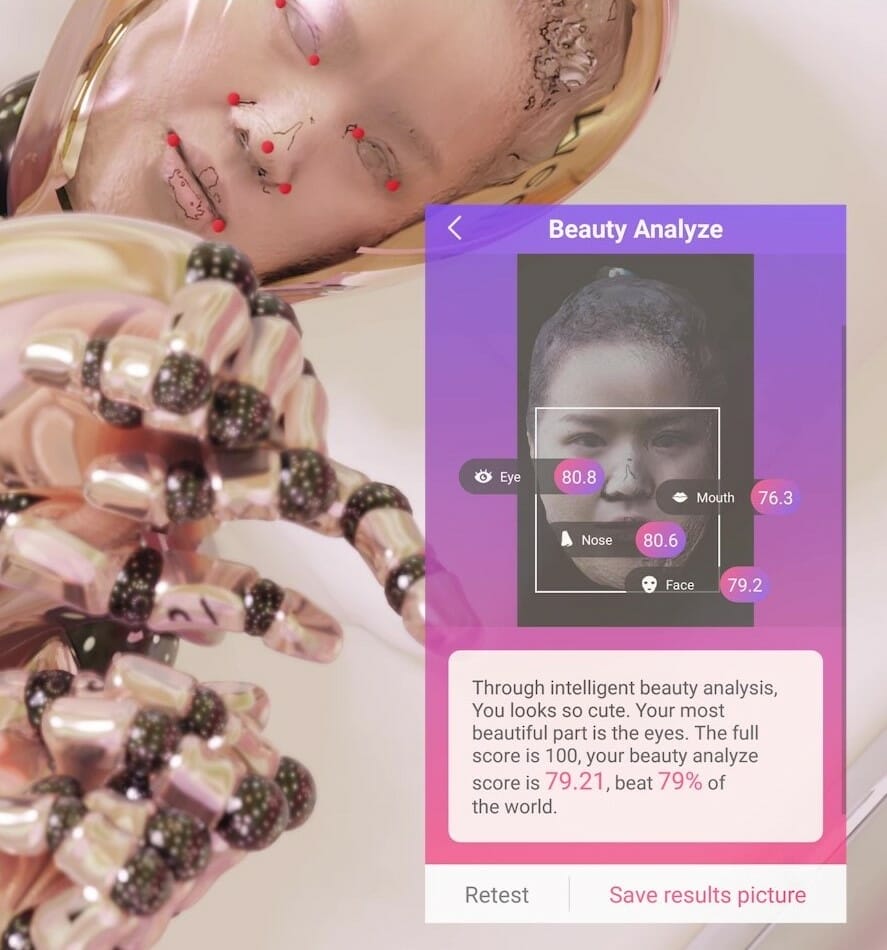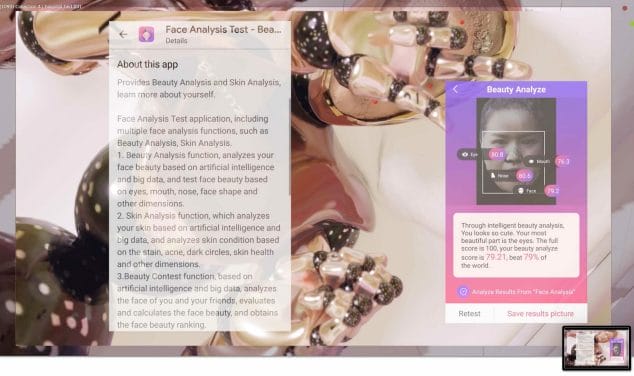Background: Chocho studio reshaping the face.
Around two cases and three videos attempt to reflect the domination and control of reality by information technology, smart phones and social media.
Chocho virtual clinic is a subsidiary of Chocho studio. The main customer groups are: Internet residents, virtual faces, beauty filter addict and the virtual modifier — doctor.
Chochos face has been analysed in first video chapter— beauty score, in order to get a higher beauty score, Chocho reshaped her virtual face after consulting doctor. In second video chapter — ForgivePo, her body is scanned and examined as a subject. The viewer is both a doctor and a web surfer. In this virtual space, Chocho interacts with information environment and the subject intervenes in real world through virtualization, perception, thinking and behaviour to give new explanations and transformations. This transition is an attempt by Internet user to regain control of the body after their virtual self-image is out of control, from being regarded to being a viewer.
Concerns from artists, social media will rationalize beauty filter even if there is bias in the algorithm. The habitual repetition of smartphone users leads to blurring of the line between consciousness and information. This will make users gradually ignore the harm of invalid information and privacy. In the digital world, women are losing the control and power over their self portraits.
In the mid-20th century, early cybernetics theorists often considered cyborg as a huge form which links machine and body, the consciousness of body modifier cyborg and information connection are mostly material, and control over the body of homo sapiens, animals, cyborgs and robots is treated differently on the basis of humanistic theories that and home sapiens are clearly different from those “non-human” things. In the late-20th century, postmodern feminism scholar Donna Haraway published her famous work titled A Cyborg Manifesto: Science, Technology, and Socialist-Feminism in the Late 20th Century, and in the eyes of cyborg feminists, technology is sexy for women, women and technology exactly can construct a picture of liberation, hence the boundaries between machine and body, consciousness and informosomes began to become blur.
After that, on the basis of the theory of Donna Haraway, N. Katherine Hayles pointed out that the intersection of technology and narrative is crucial (1) , cyborg that is part machine and part human is entity and representation, living organism and narrative structure at the same time, thus emphasizing the concept of posthuman. One of her important views is that human consciousness is like an accidental phenomenon, while visual information model focuses more on material examples, and posthuman considers the human body as an original prosthesis that can control. Thus, based on these views and other methods, posthuman redefines and configures body structure, enabling it to seamlessly combine with intelligent machine. In posthuman, there is no essential difference nor absolute dividing line between control mechanism and organism, robotic teleology and human goals. (2)
However, the facts show that since the birth of digital media and the internet, various kinds of social media have developed and become mainstream means for social communication, liberated and inclusive pictures have not happened yet, as women are gradually losing their sense of identity with their self-image and body. In The Birth of the Clinic, Foucault proposes that doctors’ gaze at patients is a presentation of wielding power, so “viewer’s gaze is dominator’s gaze”. Corresponding to this theory, viewers on social media expand their power infinitely via computer screen or smartphone with functions like browse and comment, which correspond to view.
But, the difference is that any social media user will become the subject and object of such gaze at the same time. Instagram Data Analysis Report of 2019 analyzed more than 3million posts on Instagram and counted the number of online celebrities. According to survey results, 84% of online celebrities who posted on Instagram are female, but male fans of these online celebrities are in the majority, and most of female online celebrities are called influencers while male online celebrities are mostly called creators.
Wendy Hui Kyong Chun,Professor of Modern Culture and Media at Brown University, digital media scholar and critic, proposes in his book Updating to Remain the Same: Habitual New Media (MIT 2016) that smartphone or new media have become important factors that influence behavioral habits, and we get used to the harm brought by those new technologies to privacy and identity, and even problems like racism and sexism are common. These technologies inspire hope as well as bring anxiet.
Furthermore, from the perspective of the theory of embodied cognition, our behavioral habits, living environment and body perception will influence mind and consciousness. Many users say the number of likes and others’ comments they get will directly influence their behavior and emotion when they post selfies on Instagram or WeChat Moments. It means that when the body and the virtual environment are linked via social media, human will feel passive, have a sense of anxiety and doubt their self-image and identity.
When it comes to the role and identity of artist, emerging network art, or new media art, changed the original art ecosystem again. In the post-modern society where almost everyone holds a smartphone, posthuman aesthetics is revolutionized again because of technological advancement, the way art presents itself is changed, digital art makes the public the subject of aesthetics and further diversifies display modes, digital art becomes unaccountable due to its copyability, and the scale of transmission is no longer linear transmission but interactive communication. Before the digital era, places to view artworks were particular, but places to view are no longer limited to galleries, art museums or other art institutions because of the birth of mobile phone screen, which eliminates the sense of distance. Even should we continue to use the concept of “artist”? After creator can appear in a virtual form, human, digital human and AI characters can all be art makers. Besides, after new art and politics become connected, new art and technology, technology and human have also become a discussion in contemporary art.
Scientists and network engineers are always devoted to developing the most cutting-edge technologies and hope their technologies can make a new breakthrough, while big technology companies always promise us: we will be dedicated to developing programs and artificial intelligence without any prejudice and discrimination. Meanwhile, those users who pay for it are caught in the habituation to and dependence on intelligent and digital life when enjoying the conveniences and freshness brought by these technologies. Moreover, a growing number of artists and art museums are stuck because of the anxiety and pressure brought by “daily updates” on social media. Nonetheless, whether digital media and the internet spark new horizon or bring about unavoidable anxiety, every resident in cyberspace has their own answer.
CN
背景:以作品-Chocho studio reshaping the face展开来谈。
围绕着2个案例和3个视频来试图反映信息技术,智能手机和社交媒体等对于现实的支配和控制
虚拟概念店:chocho studio旗下的chocho 虚拟诊所,主要客户人群是: 网络居民,虚拟的脸部,希望改变自己数字化面庞的人群,社交软件滤镜重度依赖者。以及虚拟改造者-医生。
2019年人工智能平台face++推出beauty score(美丽评分)功能。用户上传自己的自拍到该平台后,AI算法将会对照片中的脸庞进行运算,然后打出相应的分数——又称“颜值评分”。现在已知整形美容app如:新氧,正使用他们的基础算法和数据库。该app主要提供微整形咨询,在中国仅安卓用户平台已经有超过三百多万人下载。在对使用instagram的青少年中调查发现,有案例显示:用户希望无限靠近社交媒体中虚拟的自己,为了使现实中的脸也能变得像使用过滤镜后的脸一样,他们会选择进行微整形。在中国,部分网络居民为了成为网红也会选择去整容,从而获取更多的赞和关注。
2019年程序员微博用户@将记忆深埋,宣布完成了一项由AI技术驱动的算法,并发布app:原谅宝(ForgivePo),该算法使用面部识别技术来识别女性照片,以此判断该女性是否为色情活动工作者,并与其在社交媒体中存在的内容产生交叉关联。该项目数据库来源为:有许多活跃用户的色情网站(包括PornHub和中国最大的成人网站Caoliu)以及社交媒体平台(包括Facebook,TikTok和Weibo),从中抓取了100 TB的数据。而这些网站的视频来源其合法性无法确认。
艺术家使用3D扫描技术将自身形象与虚拟的机械体进行结合,再将人机结合体置入信息化的三维视频空间,成为名为Chocho的化身。在虚拟的诊所中,视频第一章“颜值打分”部分将Chocho的脸部进行分析,为了得到较之以前更高的颜值分数,在咨询了医生的建议后进行了虚拟的微整形。而在视频第二章“原谅宝”中Chocho的身体作为被动的主体被进行扫描和审视,观看者既是医生也是网页浏览者。而人机合体人在这一虚拟的概念空间中, 使认知主体与环境交互作用,通过虚拟,感知,思维,行为等介入真实世界给出新的说明与转换。这种转变的发生是艺术家试图在虚拟形象脱离控制后,重新获得对身体控制权的一种尝试,从被观看者转变为凝视者。
而艺术家提出的问题,第一,社交软件滤镜对于人脸的美颜化是否合理化,以及背后的算法是否存在偏见。第二,科技对于身体的影响,是否因为智能手机用户的习惯性重复,而导致意识与信息体的边界模糊, 发生了机械与身体的超脱物理性的链接。第三,女性对于数字媒体世界中自我形象的控制权是否逐渐被弱化。
在20世纪中期,早期的控制论(Cybernetics)理论者通常将赛博格认为是一种机器与身体链接的巨大形式,身体改造者赛博格的意识与信息连接大多是物质性的,对身体的控制权,将人类(Homo sapiens),动物,赛博格和机器人从人文主义的理论依据出发作不同的区别对待, 人类与这些“非人”之物是泾渭分明的。发展至20世纪末期,后现代女性主义学者唐娜•哈拉维(Donna Haraway)发表著名的《赛博格宣言:20世纪晚期的科学、技术和社会主义的女性主义》(A Cyborg Manifesto: Science,Technology,and Socialist-Feminism in the Late 20th Century),在赛博女性主义者眼中,科技对于女人来说是性感的,女人和科技恰恰能构造出一幅解放的图画,而由此机械与身体,意识与信息体的边界开始逐渐模糊化。在这之后,凯萨琳.海尔斯(N. Katherine Hayles)根据唐娜•哈拉维的理论基础指出:科技和叙事的交集是很关键性的(1)人机合体人赛博格同时是实体和表征,活动生物和叙事结构,由此强调后人类概念。其重要的观点是认为人类的意识如同偶发现象,而视信息模型更重于物质实例,而后人类将人类的身体视为学会操控的原始义肢,由此透过这些观点和其他方法,后人类重新定义和配置人体结构,使其可以和智慧机器无缝接合。在后人类中,控制机制和生物体之间,机器人的目的论(teleology)和人类的目标之间,没有本质上的不同和绝对的分野。(2)
而事实显示,从数字媒体和互联网诞生至今,各类社交媒体发展并成为社交沟通的主流方式,解放而包容性的图画并未发生,女性正逐渐失去对自我形象和身体的认同感。福柯在《临床医学的诞生》(The Birth of the Clinic)中提出认为医生对病人的注视是权力施展的呈现,因此「观看者的凝视既是主宰者的凝视」(3)。对应这一理论,在社交媒体中的观看者,其中对应着审视,浏览和评论等功能,将其权力通过电脑屏幕或智能手机无限的扩张。而不同的是,任何社交媒体用户都将同时成为这种凝视的主体和对象。2019年的Instagram数据分析报告对超过300万条Instagram帖子进行了分析,对网红的人数进行了数据统计。根据调查结果,在Instagram上创建帖子的网红中有84%是女性,而其中网红的男性粉丝的数量占据了多数,而其中女性大多被称为网红(Influencers),而男性大多被称为创造博主(Creators)。
布朗大学现代文化与媒体专业的教授,数字媒体学者,批评家Wendy Hui Kyong Chun在《更新以维持现状:习惯新媒体》( Updating to Remain the Same: Habitual New Media, MIT 2016)”一书中提出,智慧型手机或新媒体成为影响行为习惯的重要因素,我们渐渐习惯了这些新科技带来的对隐私权和对身份认同的危害,甚至种族歧视和性别歧视等问题也屡见不鲜。这些科技即激发了希望又带来了焦虑。
如进一步通过涉身性理论来看(embodied cognition),我们的行为习惯,生活环境,身体感知将影响心灵和意识。在instagram或微信朋友圈中公开发布自己的自拍照片,很多用户称被点赞的次数和其他人评论的留言会直接影响其行为与情绪。即身体与虚拟环境和透过社交媒体发生链接时产生被动感和焦虑感,并对自我的形象和身份的认同产生怀疑。
这里说到艺术家的角色与身份。新兴的网络艺术,或新媒体艺术使原有的艺术生态再次改变。而在几乎人人都手握智能手机的后现代社会中,后人类的审美又一次因科技的发展而变革,艺术自身的呈现方式发生转变,数字艺术使大众成为审美的主体,展示方式进一步多元,数字艺术的数量因其可拷贝性而不可数的,传播的规模也不再是线性传播,而是变为交互式传播。 数字时代以前的艺术品观看地点具有特定性,而因手机屏幕的诞生,观看地点不再局限于是画廊,美术馆或其他艺术机构,这使距离感消失。甚至“艺术家”这一概念是否还应该再继续使用?在创造者可做为虚拟的形式出现后,人类,数字人和人工智能的角色都可做为艺术创造者。而在新艺术与政治产生关联之后,新新艺术与科技,科技与人类也成为了当代艺术可讨论的范畴。
科学家与网络工程师总是致力于发展最前沿的科技并希望自己的技术得到新的突破,而大型科技公司总是给我们承诺:我们将致力开发没有偏见与歧视的程序和人工智能。而为此买单的用户在享受到科技的便捷和新鲜感时,也陷入了对智能化和数字化生活的习惯和依赖之中。越来越多的艺术家和美术馆,也因社交媒体中的“每日更新”带来的焦虑和压力而倍感困难。但数字媒体和互联网究竟是激发了新的视野还是带来了不可避免的焦虑,网络中的每一个居民都有自己的答案。
(1)Page 5,第五章: 从连字符号到拼接:《地狱边境》Limbo 中的控制论句法, 后人类时代,N. 凯撒琳. 海尔斯|时代出版
(2)Page 7,第一章: 朝向具体话的虚拟, 后人类时代,N. 凯撒琳. 海尔斯|时代出版
(3)Page 59, 第四章:临床医学的昔日凄凉,临床医学的诞生,米歇尔. 福柯 | 译林出版社




